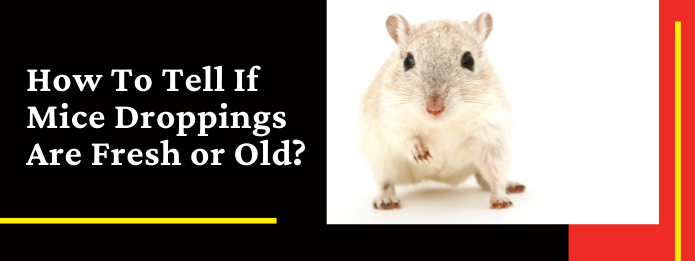How To Tell If Mice Droppings Are Fresh or Old?

Mice are small, stealthy creatures that are usually active only at night. If there are mice in your house, you are more likely to find their droppings first before you see them. An active infestation requires prompt mice removal because the rodents can cause property damage and spread disease. The age of the droppings can give you a clue as to whether the mice are still in your house.
Why Is It Important To Recognize the Age of Mouse Droppings?
Mouse droppings are not necessarily signs of an active infestation. The mice may have moved on, yet left their droppings behind. If the droppings appear to be old, it may be a sign that the infestation is over. If this is the case, then you can resolve the problem by carefully cleaning up the droppings using appropriate personal protective equipment, e.g., gloves and a mask, to prevent the spread of disease.
On the other hand, the age of the droppings alone is not an adequate indicator of whether you have an active infestation. Mouse droppings start to take on an old appearance after two to three days. If you find old droppings, keep a close eye on the area after cleaning them up. If there are no more droppings, then you probably do not have mice in your home. On the other hand, if droppings appear again in the same place, you should call pest control services in Kitchener right away.
How Can You Tell How Old the Droppings Are?
Mouse droppings are small pellets about a quarter of an inch long. They are about the size and shape of a grain of rice, with tapered ends. The colour depends on what the mice have been eating, but they are usually black or dark brown in colour. When mouse droppings get old, the colour appears more faded.
When mouse droppings are fresh, they have a wet appearance. The moisture is evident on the surface. When the droppings or older, the moisture evaporates. Older droppings have a dusty, drier appearance.
Mice can carry hantavirus, a pathogen that can cause severe respiratory illness in human beings. The virus spreads by the inhalation of aerosolized particles from the mouse droppings. Therefore, it is not recommended to handle them unless you are wearing appropriate PPE. However, if you do handle mouse droppings while properly protected, you can garner even more clues as to their age. Fresh mouse droppings are soft, and if you apply pressure to them, they will squish. Older droppings are harder, and if you crush them, they will crumble.
What Else Can Rodent Droppings Tell You?
You can also tell by the droppings whether the rodents infesting your home are mice or rats. Rats are larger creatures than mice, and their droppings are proportionately bigger as well, measuring about a quarter of an inch. Rat droppings have more mass than mouse droppings; they are broader and do not taper at the ends the way mouse droppings do. Rat droppings tend to be more crumbly in consistency. They are more grey than black or brown in colour, but as with mice, this may depend on what the rat has been eating.
Rats produce fewer droppings a day than mice. On average, rats defecate 40 to 50 times per day while mice can do so up to 75 times. However, it is rare that a single mouse or rat is living in your home. Infestations can involve hundreds of rodents, each producing feces.
Why Should You Contact Truly Nolen for Mice Removal?
In addition to potentially spreading disease, rodents can also cause severe property damage by ripping up insulation for nesting material and chewing through electrical wires. We will recommend a course of action based on your individual needs that typically includes sanitation and exclusion, i.e., preventing the rodents from coming back, in addition to eliminating the population. Contact us today for pest control services in Kitchener.